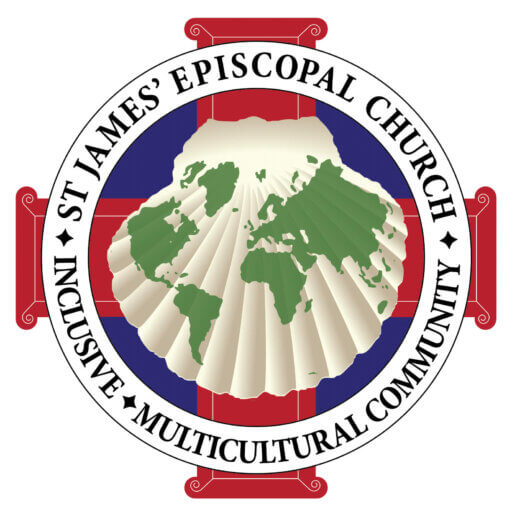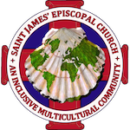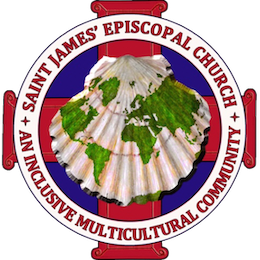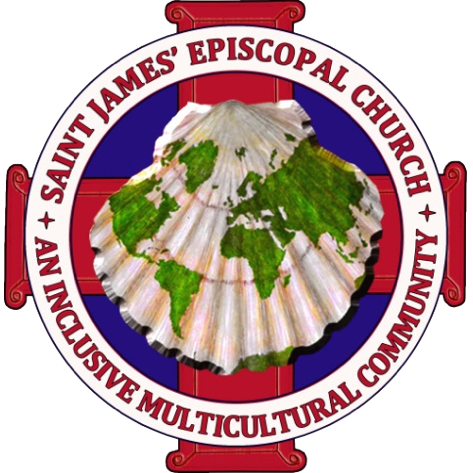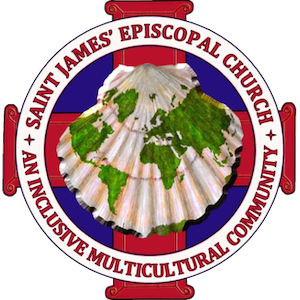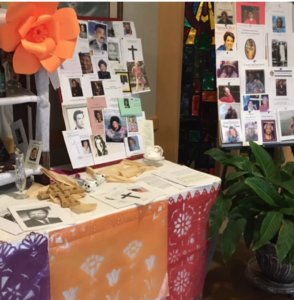
On October 30 at 10 am, you are invited to join members of Proyecto Santiago from the 1:00pm service to set up the altar in the narthex, commemorating the Mexican religious custom known as the Day of the Dead (el Día de los Muertos), when families commune with the souls of their deceased relatives for a brief reunion that includes food, drink, and celebration. Photographs, special items of remembrance, favorite food of deceased loved ones adorn the altar, along with colorful flowers and papel picado.
We will meet to set up the altar at 10:00am in the narthex. All of the people of St. James’ are invited to add photographs to altar of people whom they wish to remember.
El Día de los Muertos
Every year, members of Proyecto Santiago from the 1:00pm service set up an altar in the narthex, commemorating the Mexican religious custom known as the Day of the Dead (el Día de los Muertos), when families welcome back the souls of their deceased relatives for a brief reunion that includes food, drink, and celebration. Photographs, special items of remembrance, favorite food of deceased loved ones adorn the altar, along with colorful flowers and papel picado. 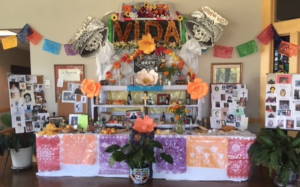
A blend of Mesoamerican ritual, European religion, and Spanish culture, the holiday is celebrated on November 1-2. The roots of the Day of the Dead go back some 3,000 years, to the rituals honoring the dead in pre-Columbian Mesoamerica. The Aztecs and other Nahua people living in what is now central Mexico held a cyclical view of the universe, and saw death as an integral, ever-present part of life.
Upon dying, a person’s soul was believed to travel to the Land of the Dead. Only after getting through nine challenging levels, a journey of several years, before finally reaching Mictlán, the final resting place. In Nahua rituals honoring the dead, family members provided food, water, and tools to aid the deceased in this difficult journey. This inspired the contemporary Day of the Dead practice in which people leave food or other offerings on their loved ones’ graves or set them out on makeshift altars called ofrendas in their homes.
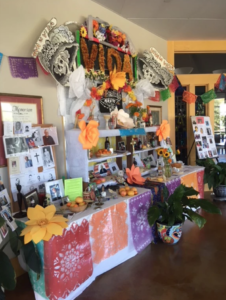 During contemporary Day of the Dead festivities, people commonly eat sugar candy molded into the shape of skulls and pan de muerto, which is like the pan de ánimas from All Souls Day rituals in Spain. Prominent symbols related to the Day of the Dead are calacas (skeletons) and calaveras (skulls).
During contemporary Day of the Dead festivities, people commonly eat sugar candy molded into the shape of skulls and pan de muerto, which is like the pan de ánimas from All Souls Day rituals in Spain. Prominent symbols related to the Day of the Dead are calacas (skeletons) and calaveras (skulls).
El Día de los Muertos is not, as sometimes thought, a Mexican version of Halloween, though the two holidays do share some traditions, including costumes and parades. Mexico City held its first-ever parade for the holiday in 2016. A number of major U.S. cities, including Chicago, Los Angeles, San Antonio, and Austin hold Day of the Dead parades. In late 2017, Disney and Pixar released the blockbuster animated hit Coco, a homage to the Mexican tradition in which a young boy is transported to the Land of the Dead and meets up with his long-lost ancestors.
People from St. James are invited to add photographs to the Day of the Dead altar of people whom they wish to remember.
Adapted from “Day of the Dead (Día de los Muertos),”The History Channel, https://www.history.com/topics/halloween/day-of-the-dead
